Asparagus is a nutrient-rich vegetable that is low in calories and a good vitamin source for A, C, and K. Asparagus (Asparagus Officinalis) belongs to the Asparagus family (Asparagaceae). If you live in the USA, you’re lucky because Asparagus grows well in many regions of the country. This article will explain how to grow Asparagus in the USA, propagate Asparagus plants, and care for your Asparagus crop.

How to grow Asparagus in USA
Soil requirement for growing Asparagus
- It is a perennial vegetable grown in most regions of the United States. It prefers full sun and well-drained soil with a pH between 6.0 and 7.5. Asparagus can be started from seed or transplanted from crowns.
- The ideal soil for Asparagus is well-drained and sandy loam. If your soil does not meet these requirements, you can improve it by adding organic matter such as compost or manure.
- Asparagus roots are deep, so it’s essential to loosen the growing soil to a depth of about 12 inches. If your soil is heavy clay or has a lot of rocks, you may need to raise the bed by adding additional organic matter and amending the soil with sand.
- Plant Asparagus in early spring as the soil can be worked. Space Asparagus plants about 18 to 24 inches in rows 4 feet apart. For best results, use crowns that have been started from seed or transplants from a nursery. Avoid using old, woody crowns from grocery store bunches, as these will not produce well.
- When planting Asparagus, dig a hole twice the width of the roots but no deeper than the root ball. Gently backfill around the plant and water deeply until moistened.
Where does the US get Asparagus?
The USA is one of the world’s leading producers of Asparagus, with California, Washington, and Michigan being the top three producing states. Asparagus is a perennial crop that is typically harvested from April to June.
In case you missed it: Controlling Mosaic Viruses in Plants: Chemically, Organically, Symptoms, and Causes
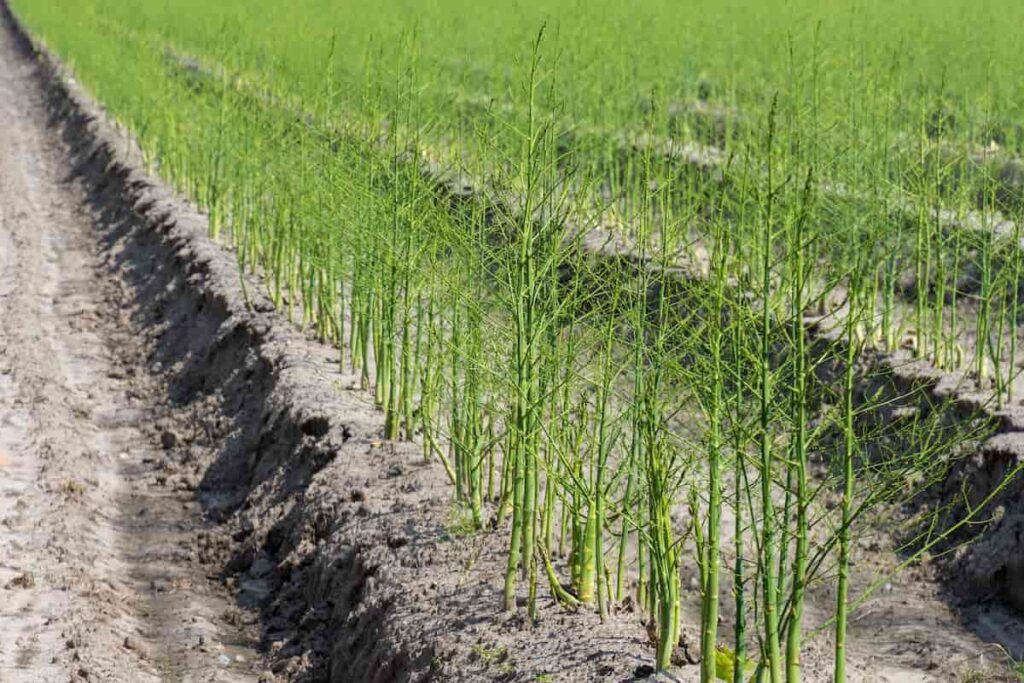
Asparagus is a cool-season crop that can be grown in most of the United States. The best Asparagus production occurs in the northern states, where the winters are cold enough to vernalize the plants (a process that helps promote early growth in the spring). California and Michigan are the top Asparagus-producing states in the country. All US commercial Asparagus production occurs in Michigan, California, Washington, and New Jersey.
Asparagus propagation methods
Asparagus is an herbaceous, perennial plant native to most of Europe, northern Africa, and western Asia. The Asparagus plant grows to 1-2 m (3-6 ft) tall, with slender stems and small scale-like leaves. The flowers are borne in small clusters, each flower with five petals. There are two main methods of propagating Asparagus: by seed or by division of the roots.
Asparagus Propagation by Seed
To propagate Asparagus by seed, sow the seeds in the late winter or early spring season in a seed tray filled with a moist potting mix. Place the tray in a warm location from direct sunlight and keep the mix moist but not wet. Once the seeds have germinated (usually within 2-4 weeks), transplant the seedlings into individual pots filled with well-drained potting mix. Grow the seedlings under cool conditions until they are large enough to transplant into the garden beds (usually after 1-2 years).
Asparagus Propagation by Root Division
To propagate Asparagus by root division, dig up an existing Asparagus plant in the late winter or early spring season before new plant growth begins. Carefully divide the root system into several sections using a sharp knife or spade. Replant each section immediately in its hole
In case you missed it: Vertical Cucumber Farming for the Urban Gardener: Clever Ways to Get More Yields from Small Spaces
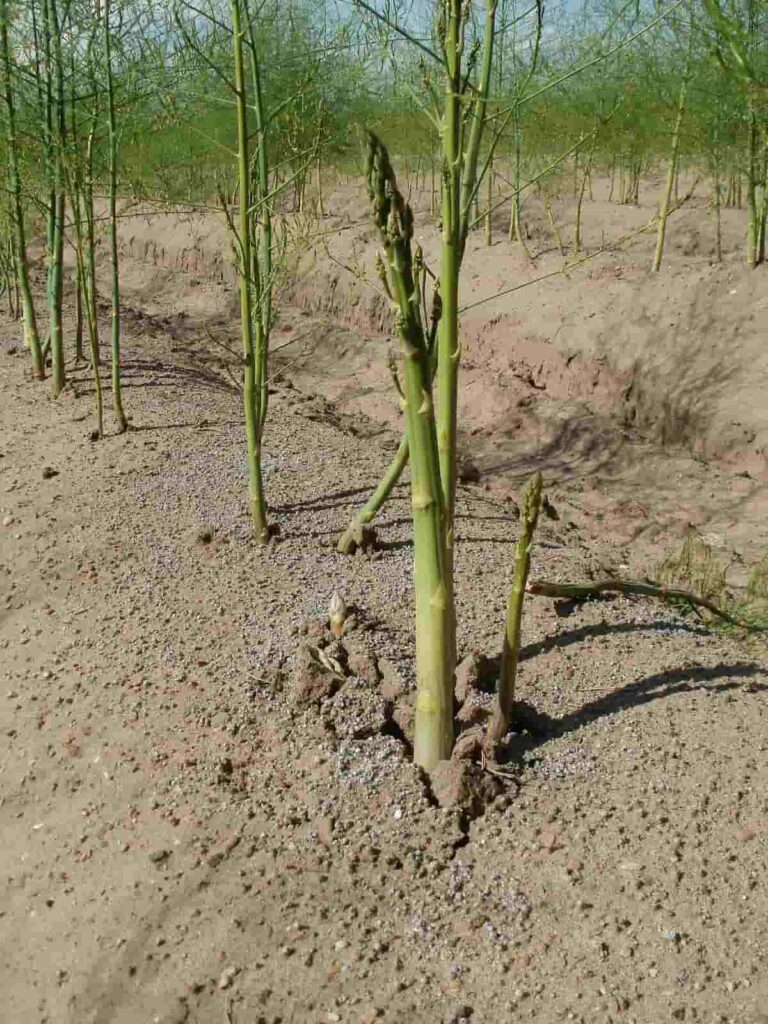
Climate conditions for growing Asparagus in the USA
- Asparagus is a cool-season crop typically grown in the United States from February to early April or from September to early November. The plant can withstand some frost and can be one of the first vegetables harvested in the spring.
- Asparagus can be grown in a variety of soils. Asparagus can be propagated by seed or by crown division. The crown division is the most common method used by commercial growers.
- Asparagus should be grown in the spring season after all danger of frost has passed. Choosing a planting site that receives full sun and has good drainage is important. The planting hole should be dug 18 to 24 inches deep and wide enough to accommodate the roots without crowding them.
- Once planted, Asparagus requires very little care. It should be fertilized once per year, in early spring, with a balanced fertilizer such as 10-10-10. Mulching around the plants will help to keep weeds at bay and conserve moisture. Although Asparagus is drought tolerant, it benefits from regular watering during prolonged dry periods.
Can Asparagus grow in Florida?
Asparagus is a hardy vegetable that can be grown in many different climates, including Florida. The key to success when growing Asparagus in Florida is to choose a variety that is well-suited to the warm climate. There are different varieties of Asparagus, so research to find one that will do well in your area. Once you have selected a variety, it is important to prepare the soil properly. Asparagus prefers well-drained, sandy soil. If your soil is heavy or clay-like, consider amending it with sand or compost to improve drainage.
Once the Asparagus plants have established themselves, they will need little care other than regular watering and occasional fertilization. However, it is important to watch out for pests and diseases that could damage the crop. Common problems in Florida include aphids, Asparagus beetles, and root rot. If you notice any of these problems, take action immediately to prevent further damage.
Asparagus growing in Mexico
Asparagus is a perennial vegetable plant that can be grown in most parts of the USA. The Asparagus plant is native to the temperate Northern Hemisphere regions. It has been cultivated for over 2,000 years and was once a prized delicacy of the Roman Empire. Today, Asparagus is widely available in supermarkets and is a popular addition to many recipes. While Asparagus can be grown in any state, it thrives in warm climates with long growing seasons.
Mexico is one country where Asparagus cultivation has become popular in recent years. There are several reasons why Asparagus grows so well in Mexico. First, the climate is ideal for Asparagus production, with warm days and cool nights. The soil in Mexico is also rich in nutrients, which helps the plants to grow strong and healthy. In addition, Mexican farmers have developed efficient irrigation systems that help to keep the plants properly hydrated during the dry season.
In case you missed it: Pest and Disease Management in Sugarcane: Causes, Symptoms, Chemical, and Biological Control
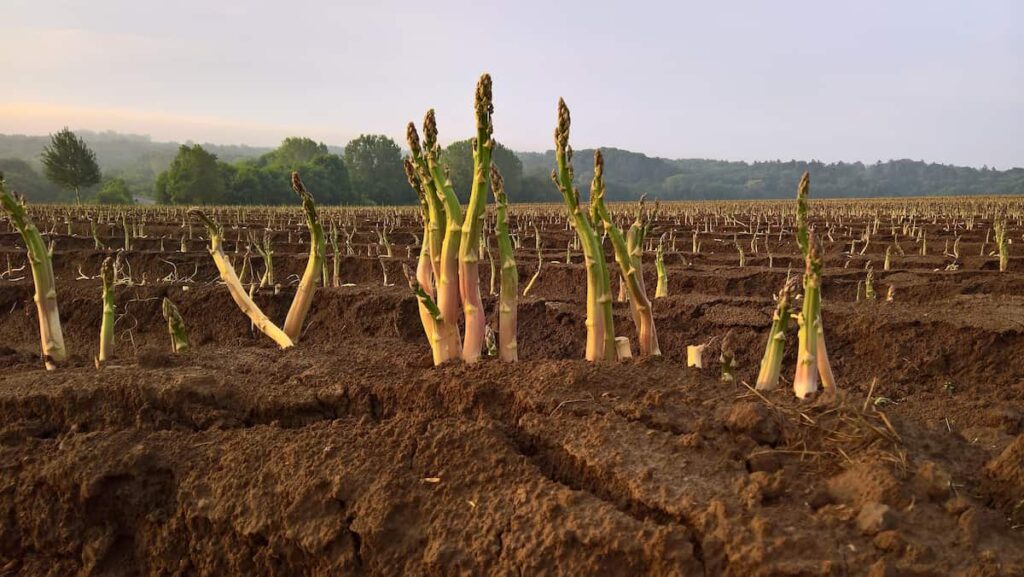
Asparagus production and yield in the USA
- Most of the Asparagus harvested in the USA is sold as fresh produce. The USA produces around 20,000 to 25,000 acres of Asparagus with approximately $70 to $100 million annually.
- It is produced on 4,900 farms in the USA, and 75 percent of those farms have one acre or less.
- Asparagus is a popular vegetable crop in the United States. The main producing states are California, Washington, and Michigan.
Asparagus planting in the USA
- Asparagus is a healthy, delicious, low-maintenance vegetable that can be easily grown in the USA. All you need is well-drained soil and full sun. It is a perennial plant that comes back yearly with very little care.
- Asparagus is a delicious, nutritious, and versatile vegetable that can be enjoyed fresh, canned, or frozen. It’s easy to grow Asparagus in the USA, and with a little care and attention, you can enjoy a bountiful harvest of this tasty vegetable.
- When growing Asparagus in the USA, choosing a location with well-drained soil and full sun is important. Asparagus plants are deep-rooted, so they need room to grow.
- To get started, purchase Asparagus crowns from your local nursery or garden center. You can also order them online. Plant the crowns in early spring, as soon as the ground can be worked.
- Dig a trench that is 6 inches deep and 12 inches wide. Place the crowns in the trench, so the roots are spread out and the budding tips point up. Cover the crowns with about 2 inches of soil and water well.
- As the Asparagus spears grow, fill the trench with more soil until it is level with the surrounding soil. Keep the plants watered during dry periods. When spears are 8 inches tall, cut them off at ground level to allow the Asparagus plant to put its energy into developing strong roots for next year’s crop.
- You can use harvesting Asparagus when the plants are 3 years old. Spears should be at least 6 inches tall before you cut them. To harvest, snap off the spear where it meets resistance when gently bent. Be sure to leave spears unharvested so the Asparagus plant can continue producing food.
Tips for Asparagus growing in the USA
- Asparagus is a perennial vegetable plant that can be harvested for several weeks in the spring. In the United States, Asparagus season generally begins in early April and lasts until mid-May. Asparagus plants can live for 20 to 30 years, so choosing a site for your Asparagus patch will provide good drainage, and full sun is important.
- To prepare the bed for planting, loosen the soil to a depth of 12 inches with a spade or tiller. Add 2 to 4 inches of organic matter like compost or manure, and mix it into the top 6 inches of soil. If your soil is heavy clay or very sandy, you may need to amend it with other organic matter.
- Asparagus is usually propagated by root crowns or “crowns” that are 1 to 2 years old. You can purchase crowns from a nursery or online retailer specializing in Asparagus plants.
- Once your Asparagus plants are established, they will need little care other than regular watering.
In case you missed it: How to Grow Krishna Kamala from Seeds and Cuttings: At Home, In Pots, Steps, Planting, and Care
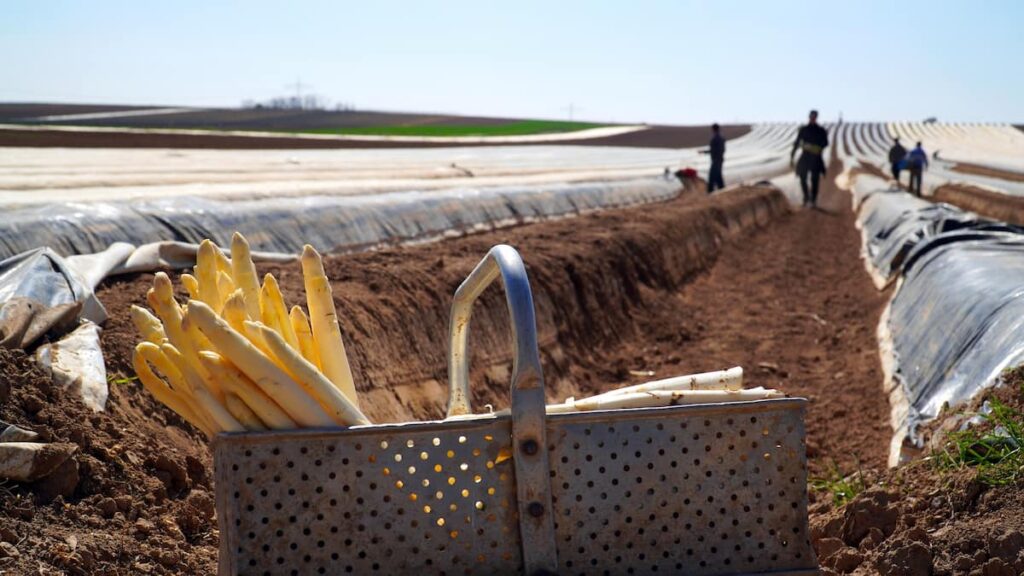
Asparagus varieties in the USA
There are three main types of Asparagus grown in the United States: green, white, and purple. Green Asparagus is the most common type grown and find in most grocery stores. White Asparagus is less bitter than green Asparagus and has a more delicate flavor. Purple Asparagus is a hybrid of green and white Asparagus and has a sweeter flavor. Asparagus is a popular vegetable crop in the United States.
While many varieties of Asparagus are available, the most common types grown in the US are Green Asparagus and White Asparagus. Green Asparagus is the most popular type of Asparagus grown in the US. This variety is easy to process to grow and produces high yields. The spears are tender and have a mild, nutty flavor.
White Asparagus is less common than green Asparagus, but it is still grown in some parts of the country. This variety has a more delicate flavor than green Asparagus and is often harvested before it turns green. White Asparagus spears are also more expensive than green Asparagus due to the extra care required to grow them.
Asparagus plant care
- Asparagus is a low-maintenance crop that requires regular watering and weed control. Fertilize Asparagus beds in early spring and again after harvest.
- Asparagus is a water-loving plant, so it’s essential to ensure you’re giving it enough water. Depending on your climate, Asparagus will need 1-2 inches of water per week. If you let the soil dry out too much, the Asparagus will start to go dormant and won’t produce any new shoots.
- Fertilizer is also important for healthy Asparagus plants. Every spring, apply a balanced fertilizer to the Asparagus bed. You can also side-dress with compost every few weeks during the growing season.
- Fertilize Asparagus plants with a 10-10-10 fertilizer once a month during the growing season. Stop fertilizing in late summer to avoid encouraging new growth that will not have time to mature before winter frost arrives. Asparagus plants should be mulched with 2-3 inches of organic material, such as straw or shredded leaves, in late fall to protect the plants from winter cold and frost damage.
Pests and diseases management for growing Asparagus in the USA
Pests and diseases can be a problem with Asparagus, but there are some essential things you can do to prevent them. First, make sure you’re planting in well-drained soil to reduce the chances of root rot. Second, choose a disease-resistant variety of Asparagus if possible. And finally, keep an eye out for insects and pests and remove them by hand if possible.
In case you missed it: How to Make Coco Peat at Home: Process, Steps, and Guide
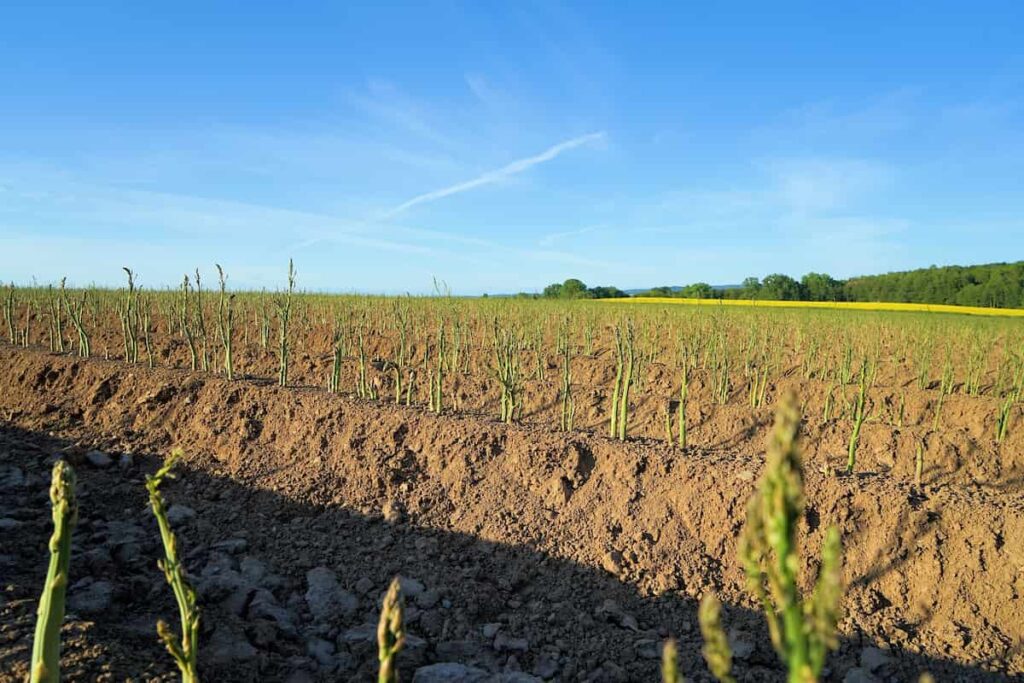
Asparagus is a delicious and nutrient-rich vegetable that can be enjoyed fresh, canned, or frozen. This perennial member of the lily family can quickly grow in most garden soil with full sun. While Asparagus is a hardy plant that can tolerate some neglect, there are a few pests and diseases that can cause problems for your crop. Here are some of the most common Asparagus pests and diseases:
Asparagus Beetles
The Asparagus beetle is the most common pest of Asparagus plants. These small, dark beetles feed on the foliage of Asparagus plants, causing the leaves to turn brown and wilt. The larvae of Asparagus beetles can also damage the spears and roots of plants.
Asparagus Aphids
Aphids are soft-bodied insects. While they don’t usually cause severe damage to Asparagus plants, large infestations can stunt plant growth and make the foliage less attractive.
Rust Diseases
Several rust diseases can affect Asparagus plants, causing reddish-brown spots on the foliage. These diseases can weaken plants and reduce yields. Fortunately, many effective treatments for these common Asparagus pests and diseases exist. Check with your local extension office for specific control recommendations for your area.
When and how to harvest Asparagus in the USA?
Asparagus is a perennial vegetable that is typically harvested in the spring. The Asparagus season can last up to eight weeks, but the peak season is usually only four to six weeks long. To harvest Asparagus, cut or snap the spears at ground level when they are 6-8 inches tall. Be sure to leave at least two inches of a spear above the soil surface to allow for regrowth.
New spears will continue to grow even after you have harvested the older ones so that you can enjoy fresh Asparagus all season long. You can harvest Asparagus daily during the season’s peak if you have enough plants. Once you have harvested all the Asparagus you want, allow the plants to grow undisturbed until mid-July. This will allow them to produce the ferns necessary for next year’s crop. After mid-July, you can cut back the ferns to about 6 inches tall to tidy up the plant and encourage new growth.
Conclusion
Asparagus plants are dioecious, meaning female and male flowers are produced on different plants. Asparagus prefers full sun but will tolerate partial shade. These health benefits make Asparagus a vegetable worth growing in your home garden.
- How to Build a Low-budget Goat Shed: Cheap Ideas and Tips
- Goat Farming Training Programs in India: A Beginner’s Guide
- Types of Pesticides Used in Agriculture: A Beginner’s Guide
- Economical Aquaculture: A Guide to Low-Budget Fish Farming
- 15 Common Planting Errors That Can Doom Your Fruit Trees
- How to Make Houseplants Bushy: Effective Tips and Ideas
- Innovative Strategies for Boosting Coconut Pollination and Yield
- Pollination Strategies for Maximum Pumpkin Yield
- The Complete Guide to Chicken Fattening: Strategies for Maximum Growth
- Natural Solutions for Tulip Problems: 100% Effective Remedies for Leaf and Bulb-Related Issues
- Revolutionizing Citrus Preservation: Towards a Healthier, Greener Future
- Natural Solutions for Peony Leaf and Flower Problems: 100% Effective Remedies
- Maximizing Profits with Avocado Contract Farming in India: A Comprehensive Guide
- Natural Solutions for Hydrangea Problems: 100% Effective Remedies for Leaf and Flowers
- The Ultimate Guide to Choosing the Perfect Foliage Friend: Bringing Life Indoors
- From Sunlight to Sustainability: 15 Ways to Use Solar Technology in Agriculture
- The Ultimate Guide to Dong Tao Chicken: Exploring from History to Raising
- The Eco-Friendly Makeover: How to Convert Your Unused Swimming Pool into a Fish Pond
- Mastering the Art of Delaware Chicken Farming: Essentials for Healthy Backyard Flocks
- 20 Best Homemade Fertilizers for Money Plant: DIY Recipes and Application Methods
- How to Craft a Comprehensive Free-Range Chicken Farming Business Plan
- Brighten Your Flock: Raising Easter Egger Chickens for Beauty and Bounty
- How to Optimize Your Poultry Egg Farm Business Plan with These Strategies
- Subsidy for Spirulina Cultivation: How Indian Government Schemes Encouraging Spirulina Farmers
- Ultimate Guide to Raising Dominique Chickens: Breeding, Feeding, Egg-Production, and Care
- Mastering the Art of Raising Jersey Giant Chickens: Care, Feeding, and More
- Ultimate Guide to Raising Legbar Chickens: Breeding, Farming Practices, Diet, Egg-Production
- How to Raise Welsummer Chickens: A Comprehensive Guide for Beginners
- How to Protect Indoor Plants in Winter: A Comprehensive Guide
- Ultimate Guide to Grow Bag Gardening: Tips, Tricks, and Planting Ideas for Urban Gardeners
- Guide to Lotus Cultivation: How to Propagate, Plant, Grow, Care, Cost, and Profit
- Agriculture Drone Subsidy Scheme: Government Kisan Subsidy, License, and How to Apply Online
- Ultimate Guide to Raising Araucana Chickens: Breed Profile, Farming Economics, Diet, and Care
- Bringing Hydroponics to Classroom: Importance, Benefits of Learning for School Students
- Ultimate Guide to Raising Polish Chickens: Breed Profile, Farming Economics, Diet, and Care
- Ultimate Guide to Raising Australorp Chickens: Profile, Farming Economics, Egg Production, Diet, and Care
Complete information about asparagus thank you a helpful article for any asparagus lover